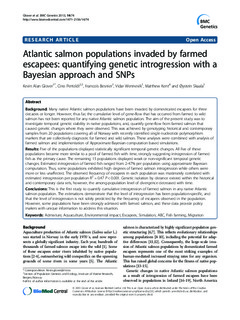| dc.contributor.author | Glover, Kevin A. | |
| dc.contributor.author | Pertoldi, Cino | |
| dc.contributor.author | Besnier, Francois | |
| dc.contributor.author | Wennevik, Vidar | |
| dc.contributor.author | Kent, Matthew | |
| dc.contributor.author | Skaala, Øystein | |
| dc.date.accessioned | 2013-10-23T12:15:51Z | |
| dc.date.available | 2013-10-23T12:15:51Z | |
| dc.date.issued | 2013-08-23 | |
| dc.identifier.citation | Atlantic salmon populations invaded by farmed escapees: quantifying genetic introgression with a Bayesian approach and SNPs Kevin Alan Glover, Cino Pertoldi, Francois Besnier, Vidar Wennevik, Matthew Kent, Øystein Skaala BMC Genet. 2013; 14: 74. | no_NO |
| dc.identifier.issn | 1471-2156 | |
| dc.identifier.uri | http://hdl.handle.net/11250/109212 | |
| dc.description.abstract | Background
Many native Atlantic salmon populations have been invaded by domesticated escapees for three decades or longer. However, thus far, the cumulative level of gene-flow that has occurred from farmed to wild salmon has not been reported for any native Atlantic salmon population. The aim of the present study was to investigate temporal genetic stability in native populations, and, quantify gene-flow from farmed salmon that caused genetic changes where they were observed. This was achieved by genotyping historical and contemporary samples from 20 populations covering all of Norway with recently identified single nucleotide polymorphism markers that are collectively diagnostic for farmed and wild salmon. These analyses were combined with analysis of farmed salmon and implementation of Approximate Bayesian computation based simulations.
Results
Five of the populations displayed statistically significant temporal genetic changes. All five of these populations became more similar to a pool of farmed fish with time, strongly suggesting introgression of farmed fish as the primary cause. The remaining 15 populations displayed weak or non-significant temporal genetic changes. Estimated introgression of farmed fish ranged from 2-47% per population using approximate Bayesian computation. Thus, some populations exhibited high degrees of farmed salmon introgression while others were more or less unaffected. The observed frequency of escapees in each population was moderately correlated with estimated introgression per population R2 = 0.47 P < 0.001. Genetic isolation by distance existed within the historical and contemporary data sets, however, the among-population level of divergence decreased with time.
Conclusions
This is the first study to quantify cumulative introgression of farmed salmon in any native Atlantic salmon population. The estimations demonstrate that the level of introgression has been population-specific, and that the level of introgression is not solely predicted by the frequency of escapees observed in the population. However, some populations have been strongly admixed with farmed salmon, and these data provide policy makers with unique information to address this situation. | no_NO |
| dc.language.iso | eng | no_NO |
| dc.publisher | BioMed Central | no_NO |
| dc.subject | environmental impact | no_NO |
| dc.subject | miljøpåvirkning | no_NO |
| dc.subject | farmed fish escape | no_NO |
| dc.subject | fiskerømning | no_NO |
| dc.subject | migration | no_NO |
| dc.subject | vandringer | no_NO |
| dc.title | Atlantic salmon populations invaded by farmed escapees: quantifying genetic introgression with a Bayesian approach and SNPs | no_NO |
| dc.type | Journal article | no_NO |
| dc.type | Peer reviewed | no_NO |
| dc.subject.nsi | VDP::Agriculture and fishery disciplines: 900::Fisheries science: 920::Aquaculture: 922 | no_NO |
| dc.source.pagenumber | 19 s. | no_NO |
| dc.source.volume | 14 | no_NO |
| dc.source.journal | BMC Genetics | no_NO |
| dc.source.issue | 74 | no_NO |
| dc.identifier.doi | 10.1186/1471-2156-14-74 | |
